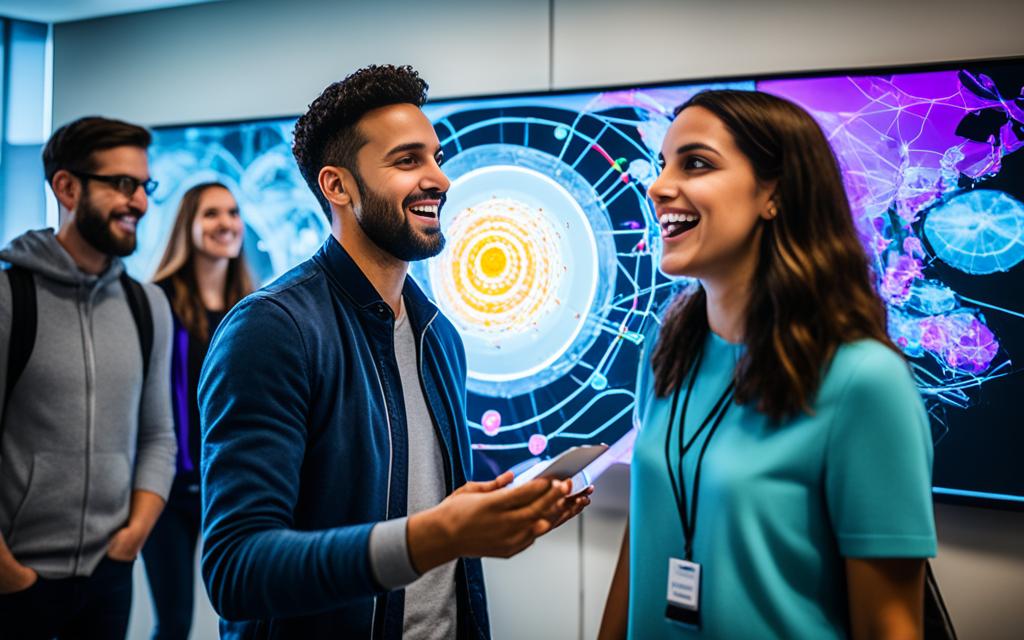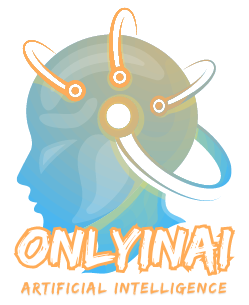Did you know 47% of schools in the U.S. now use AI tools? This shows how fast smart learning tech is becoming common in classrooms. AI is changing how students learn and teachers teach.
Now, educational tech is a must-have in modern classrooms. AI offers personalized learning and smart tutoring. It’s making learning more fun and effective than ever.
Adding AI to schools is not just about cool gadgets. It’s about getting our kids ready for a future filled with AI. By teaching them about AI early, we’re giving them the skills they need to succeed. Learning about coding and machine learning is now as important as reading and writing.
Key Takeaways
- 47% of U.S. schools use AI-powered educational tools
- AI is transforming traditional teaching methods
- Smart learning platforms offer personalized education
- AI literacy is becoming essential for future success
- Educational technology enhances student engagement
Introduction to AI in Education
AI is changing education, offering new ways for schools and students to learn. It’s making teaching and learning more tailored and efficient.
The Growing Importance of AI Literacy
Knowing about AI is key in our digital world. Students need to grasp AI basics for future jobs. Schools are adding AI lessons to get students ready for a tech-filled future.
Current Trends in Educational Technology
Educational tech is changing fast. Machine learning creates smart study plans for students. Natural language processing helps with reading and writing. Virtual tutors offer personalized help, adjusting to each student’s needs.
AI’s Potential to Transform Learning Experiences
AI can change how students learn. It can make lesson plans fit each student’s learning style. AI tools can grade work quickly, giving students fast feedback. Virtual reality powered by AI can take students on exciting learning trips without leaving class.
| AI Application | Benefit |
|---|---|
| Personalized Learning | Tailored lessons for each student |
| Automated Grading | Quick feedback on assignments |
| Virtual Reality | Immersive learning experiences |
As AI grows, it’s exciting to see how it will shape education’s future. These tools could make learning more fun, engaging, and effective for all students.
Understanding AI for Schools and Kids’ Education
AI is changing how we teach and learn in schools. It uses smart algorithms to make learning more tailored and effective. Let’s see how AI is impacting classrooms in the United States.
AI in education can understand language and speech. This helps teachers and students in many ways. For instance, it can change spoken words into text or text into speech. This is great for kids who prefer listening or struggle with reading.
Intelligent tutoring systems are a big part of AI in schools. These systems can:
- Adapt to each student’s learning pace
- Provide instant feedback on assignments
- Suggest extra practice for tough topics
AI also helps teachers do their jobs better. It looks at test scores, homework, and class behavior. With this info, AI can see what kids need to learn and how to teach it best. This makes lessons more focused and helpful for everyone.
“AI in education is like having a personal coach for every student, helping them learn in ways that work best for them.”
As AI grows in education, we’ll see more creative ways to learn. Virtual field trips, interactive stories, and games that teach will become common. These tools will make learning fun and keep kids interested in their studies.
Personalized Learning with AI
AI is changing education by making learning personal. It adjusts to what each student needs. This creates a unique way to learn that was hard to do before.
Adaptive Learning Platforms
Adaptive learning platforms use AI to change the difficulty of content based on how students do. They look at how students respond and learn to give them lessons just for them. For instance, if a student finds fractions tough, the platform might give them more practice or different explanations.
Intelligent Tutoring Systems
AI-powered tutoring systems work like virtual teachers. They help students one-on-one. They can answer questions, explain things, and help with tough topics. These systems are always there, so students can learn whenever they want.
Customized Curriculum Development
AI makes learning plans by looking at student data and finding what they need to work on. This customization means each student gets a plan that fits their strengths and weaknesses.
| Feature | Benefit |
|---|---|
| Adaptive Content | Matches difficulty to student skill level |
| Real-time Feedback | Immediate correction and guidance |
| Progress Tracking | Detailed insights into student performance |
| Personalized Recommendations | Suggests relevant resources and activities |
By using AI in education, schools can make learning more fun and effective for all students.
AI-Powered Tools for Teachers
Teachers now have access to advanced AI tools that change their work. These tools make tasks easier and more efficient in the classroom. They help with everything from planning lessons to checking student work, changing how teachers do their jobs.
MagicSchool is a popular tool for teachers. It helps save time and lowers stress. It has features for making lesson plans, teaching different students, and writing tests. It also makes talking between teachers and students better.
Microsoft Education offers great resources for teachers interested in AI:
- AI for Educators training program
- Flip AI series for educators
- Microsoft Education AI Toolkit
These resources give teachers the knowledge and strategies they need to use AI in schools. They cover topics like speech recognition and sentiment analysis. These can make students more engaged and improve their learning.
AI is changing how teachers work. It automates routine tasks, letting teachers focus on what’s important. As these tools get better, they promise to make teaching more effective and fun for teachers and students.
Enhancing Student Engagement through AI
AI is changing education by making learning fun and interactive. Now, educational tech includes cool features that keep students interested in their lessons.
Gamification and AI in Learning
Games make learning fun. AI-powered games adjust to each student’s level, offering the perfect challenge. These games use speech recognition for language practice and sentiment analysis to check emotions.
Virtual and Augmented Reality in Education
Virtual field trips take students on adventures without leaving class. With VR headsets, they can explore ancient ruins or coral reefs. AR apps make textbook pictures come alive, helping students understand tough concepts better.
AI-Driven Interactive Content
AI makes learning materials that react to students’ actions. Interactive stories change based on what the reader chooses, and smart worksheets offer tips when needed. These tools use natural language processing to understand what students say and give feedback.
“AI in education isn’t about replacing teachers. It’s about giving them superpowers to engage and inspire students in new ways.”
By using AI, schools can offer deep, engaging learning experiences. These experiences spark students’ imaginations and make them more eager to learn.
Developing AI Literacy in Students

Preparing students for a future with AI means teaching them about AI literacy. Schools are starting programs to teach machine learning and natural language processing. These programs help young people get ready for an AI-driven world.
The Classroom toolkit for AI is a great resource for teachers. It helps start discussions on using AI responsibly. It covers important topics like data privacy and ethical AI use.
Minecraft’s Hour of Code: Generation AI is another great program. It makes learning to code fun while exploring AI. Students learn to make simple algorithms and see how machines process information.
“AI literacy is becoming as crucial as reading and writing in today’s digital age.”
Schools are adding AI lessons to various subjects. Math now includes machine learning algorithms, and language arts covers natural language processing. This approach shows students how AI is used in many areas.
By teaching AI literacy early, we’re preparing the next generation. They’ll be able to shape technology’s future responsibly and creatively.
Ethical Considerations and Responsible AI Use in Education
As technology in schools gets better, worries about AI grow. Using machine learning in education right means paying attention to privacy, fairness, and how students act online.
Privacy and Data Protection
AI tools in learning gather a lot of student data. Schools must make sure this data is safe and private. Now, many tools have better security to keep sensitive info safe.
Addressing Bias in AI Educational Tools
AI can show biases if not made right. Teachers should check AI tools to make sure they’re fair for all students. Regular checks help find and fix biases in AI used for learning.
Promoting Digital Citizenship
It’s key to teach students to be good online citizens. This means knowing how AI affects privacy and data. Schools can add lessons on digital skills to help kids use AI safely.
| Ethical Consideration | Key Action |
|---|---|
| Privacy | Implement strong data protection measures |
| Bias | Regularly audit AI tools for fairness |
| Digital Citizenship | Teach responsible AI use and online behavior |
By tackling these ethical issues, schools can use AI’s benefits safely. Responsible AI use in education builds trust and helps all students learn better.
The Future of AI in Schools: Challenges and Opportunities

AI for schools and kids’ education is changing fast, offering both new chances and challenges. As tech in education grows, teaching kids about AI becomes more important. Schools must blend machine learning into classes while dealing with concerns.
Personalized learning is a big chance. AI can adjust content for each student, making learning better. Teachers get tools that save time, letting them connect more with students.
Getting students more involved is another big plus. AI makes learning fun with interactive content and games. Virtual reality takes students on adventures, making lessons come alive.
But, there are hurdles. Using AI responsibly is key. Schools must make sure:
- Data privacy and security
- Fairness in AI-powered tests
- Dealing with biases in algorithms
Keeping up with AI changes is hard. Teachers need ongoing training to use new tools well. The education world must quickly adapt to get students ready for an AI-filled future.
“AI in education isn’t just about technology; it’s about reimagining how we learn and teach.”
As we welcome AI into schools, finding a balance between innovation and ethics is vital. The future of learning looks bright, with AI set to open new doors in educational tech.
Conclusion
AI for schools and kids’ education is changing how we learn. It’s making classes more fun and helpful for students. Now, each child gets a learning experience tailored to their needs.
Teachers are getting cool AI tools too. These tools save time and help them teach better. Students can now learn through games, virtual reality, and other exciting ways. This makes school more engaging and interesting.
As educational technology grows, it’s important for everyone to understand AI. We need to use AI wisely in our schools. This means keeping student information safe and making sure AI treats all kids fairly. By doing this, we can create smarter classrooms that prepare kids for a world where AI will be everywhere.


